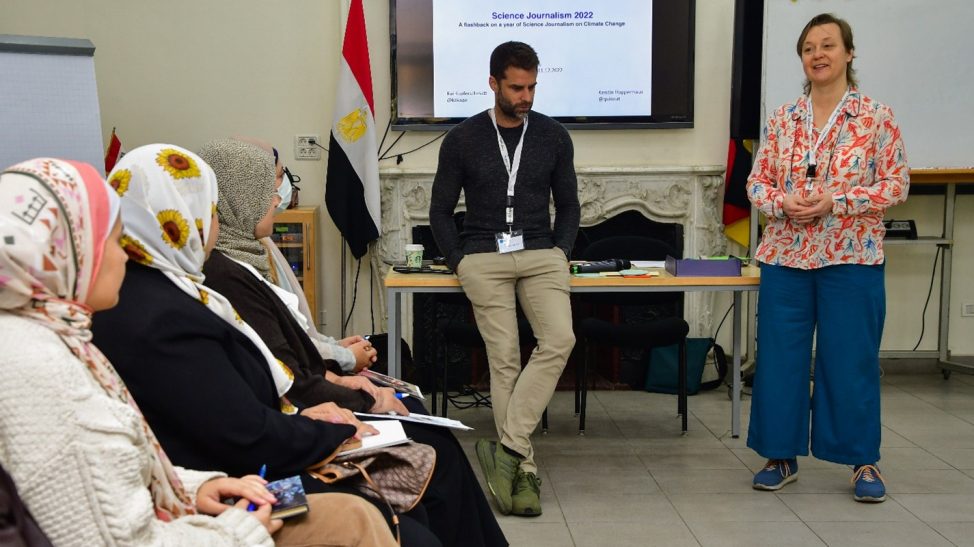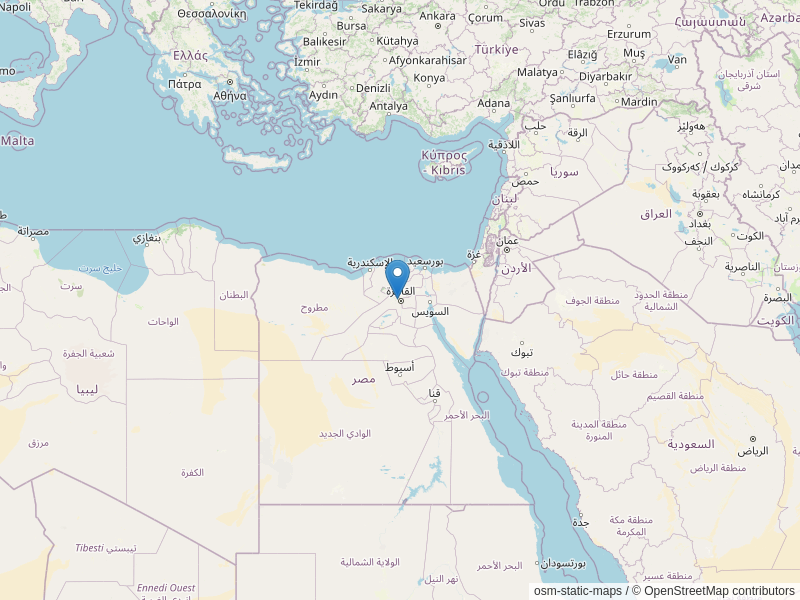Science Journalism 2022 - “A flashback on a year of Science Journalism on Climate Change”

Science Journalism is gaining a more prominent role at universities and in the media sector now. Especially through the Covid-19 pandemic, the role of science journalists in raising awareness and communicating scientific findings became eminent and shed light on the linkage between scientists, researchers, journalists and society.
Nowadays, there is furthermore no doubt that climate change is a major topic. And with COP27 having just ended, the conference put the spotlight on scientists and journalists to work together to give the public insights into the latest findings about climate change and the agreements which COP27 entails and how this will affect our daily lives.
In this regard, the interactive workshop brings together scientists, researchers and journalists from Germany and Egypt. Kai Kupferschmidt, a science journalist based in Berlin, and Kerstin Hoppenhaus, a freelance science journalist and filmmaker based in Berlin, acted as workshop trainers and built the content of the two-day workshop around the question “How can science journalists raise awareness and promote climate action to the non-scientific community?”
On the first day, 11th December 2022, special attention was paid to the situation in Egypt. The group of scientists and journalists was asked various questions and statements around the topic of “climate change reporting in Egypt”.
The first question asked was if “Media coverage of climate change is generally good in Egypt”. The 17 participants disagreed with the answer. Six of the participants voted “yes”, and seven voted “no”. However, both groups had one thing in common, as they both talked about COP27 in this context. The approvers felt that the conference was a new starting point for balanced climate change coverage, but the rejecters only saw laudatory coverage in relation to the event, but not in relation to the topic and the problems of climate change. In addition, the participants noticed a lack of addressing farmers and many other groups.
Another important question asked was, if “people in Egypt are aware of the problem of climate change”. This time, the participants agreed much more. Only three voted “yes” on this question and ten voted “no”. The participants talked about the fact that people see the changes regarding climate change but don’t know why or how to react to it. The main problem: a lack of awareness, no knowledge about the changes.
One hurdle is that a lot of journalists report the same questions and answers. The coverage climate change is very one-sided, monotonous and planned. This is also why most of the participants were not satisfied with the way COP27 and its outcome were covered by journalists in Egypt.
Kai Kupferschmidt elaborated on why the topic of climate change is reported on less than the topic of health, for example. The reason lies in the up-to-datedness of the topic. Health affects people immediately, climate related effects are much later visible, noticeable and in some cases have only local consequences. But this makes education about climate-related damage even more relevant.
To make the impact of climate change more tangible for recipients, science journalists need to ask themselves “what kind of influence can we as a society feel presently and how can I inform society about it?”.
In the second part of the first workshop day, the focus was on mediating between the different interests of scientists and journalists. Even though both groups have some needs in common, science journalism is about navigating these two cultures together.
One of the biggest hurdles, for Egyptian science journalists in climate reporting, is the lack of points of contact and information. In the “Global South Climate Database”, this problem also becomes clear in an international comparison. The database currently lists 849 experts from 102 countries, and only 20 of them speak Arabic. The lack of exchange makes it difficult for Egyptian journalists to provide technically accurate reporting.
To bring the participating journalists and scientists to a common level, they were asked the question: “what do scientists want and what do journalists want?” For scientists, answers were given like visibility, publicity, awareness and action. Journalists instead want to report the news. But there is a large difference between the relevant news topics for journalists and the news understanding of scientists.
Furthermore, scientific findings are new to journalists but have long been studied and tested by scientists. This circumstance requires that science journalists report an already long existing finding as a news item and convey the development in a comprehensible way. If the journalists do not have sufficient experts or their own knowledge at their disposal, this makes it more difficult to transmit the data correctly.
The workshop aimed at connecting scientists and journalists at this point. Both groups need to bring up understanding for each other and need to find the lowest common denominator to achieve their goals.
After a shared lunch and in the final part of the first day, it was made clear how to talk science to non-scientists and the power of words was clarified. The participants worked out the difference between scientific terms and their public understanding. An example for this is the scientific term of “uncertainty” is understood as “ignorance” by society but meant as a “range” inside scientific results. Scientists and journalists need to clarify the possible impact of language and its general understanding together.
The second day started with the perceptions of climate change news in Egypt and abroad. According to the survey, 66 percent of the citizens in Egypt believe in the current climate catastrophe and its effects. Internationally, even 8 percent more believe in the climate emergency.
The participants also worked out the most common climate change strategies and policies in the Arab countries. This includes, above all, climate-friendly agricultural farming, compost techniques and the recycling of animal feed. The scientists and journalists also talked about misunderstandings inside society, such as air conditioners causing faster global warming because of the hot blown air into the environment.
This once again highlighted the importance of exchange between scientists, journalists and society – how to educate so that all parts of society understand the background of global warming.
Subsequently the participants presented a pitch of 90 seconds about their scientific topic. Kerstin Hoppenhaus elaborated again on the significance of emotions and storytelling. As a result, exciting questions and stories emerged. For example, “do you know that women can have a huge impact on global hunger but not by just cooking food?” Another participant asked if we could ignore a glass of milk when the cow needs up to 6 liters of water for one liter of milk.
At the end of the second and last day of the workshop, the group talked once again about the effects of language, emotions and facts. After presenting all pitches, everyone elaborated on the reactions triggered by their presentations. Did they get the desired reaction from their audience, or did it fail?
Kerstin Hoppenhaus said, „emotions are powerful, but they can work also against you”, as they can cause actions, they can cause fear or hope. The participants were once again given advice on how to guide their wanted outcome and how to talk to various groups of listeners.
The workshop „Science Journalism“ ended with an inspiring debate among participants and trainers that led to new ideas and help for each other. The group of journalists and scientists has moved closer together and understood the differences but also similarities in their fields. The DAAD is very pleased about the great work and exchange of all participants and with both trainers, Kai Kupferschmidt and Kerstin Hoppenhaus, whom we are deeply thankful for.
Author: Lena Kläsgen

















